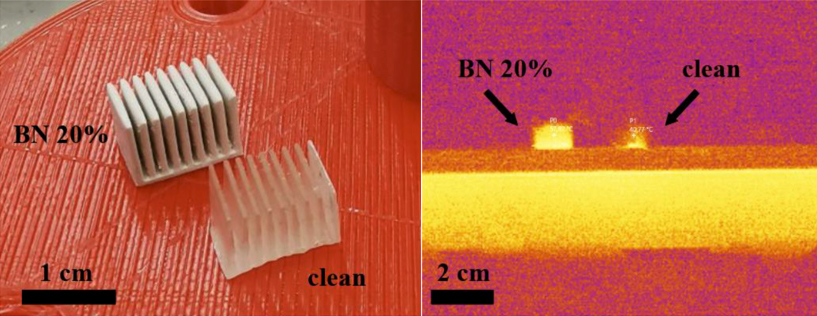Photo. “Clean” denotes a component made of the regular commercially used photopolymer, and “BN 20%” indicates the same part manufactured using that polymer with the addition of 20% by volume of boron nitride. As seen in the thermal image on the right, the BN filling leads to efficient heat dissipation, reducing the risk of overheating for microchips surrounded by this material. Credit: Julia Bondareva et al./Polymers
A research team from Skoltech has improved the properties of a polymer used in 3D printing. By adding boron nitride “flakes” to the photopolymer, the scientists managed to double the material’s thermal conductivity. This could prevent microchips encapsulated with the polymer from overheating and thus enable microelectronic devices that are smaller and more powerful. The paper came out in Polymers.
“The printing technology we devised is a step toward fusing microelectronics and additive technology,” study co-author Assistant Professor Stanislav Evlashin of Skoltech Materials commented. “While prior research tended to focus on printing conductive contacts for flexible electronics, we undertook to improve the properties of polymers suitable for microchip packaging — that is, for making the outer capsule of a microchip.”
As electronics get smaller, the issue of overheating gets more acute. When crammed into a smaller volume, the same amount of power results in faster overheating and device failure. To address this, materials with better thermal conductivity need to be used.
The chips themselves are made of silicon, which conducts heat well, but the capsule housing the device might get in the way of heat transfer because of its low thermal conductivity. The material used for this external packaging in the case of devices of complex shape is photopolymer — a paste that solidifies when exposed to radiation in a 3D printer. This photopolymer is the material whose properties were improved in the Skoltech study.
“The desirable characteristics for this photopolymer to be applicable in microchip packaging is that it should conduct heat well while not conducting electricity,” Skoltech Materials researcher and study co-author Daniil Chernodubov explained. “We went as far as to actually double the material’s thermal conductivity, without compromising its insulating properties or mechanical strength. To achieve this, we filled the polymer with another compound, called boron nitride, in the form of flakes, in the amount of 20% by volume.”
“The actual technique we used for printing is known as digital light polymerization,” Evlashin added. “It has a high resolution and is suitable for packaging devices of complex shapes. It can also be used to print the capsule directly on a silicon chip. The polymer’s enhanced thermal conductivity will ensure the stability and integrity of electronic components and allow them to work at higher operating characteristics.”
Contact information:
Skoltech Communications
+7 (495) 280 14 81

